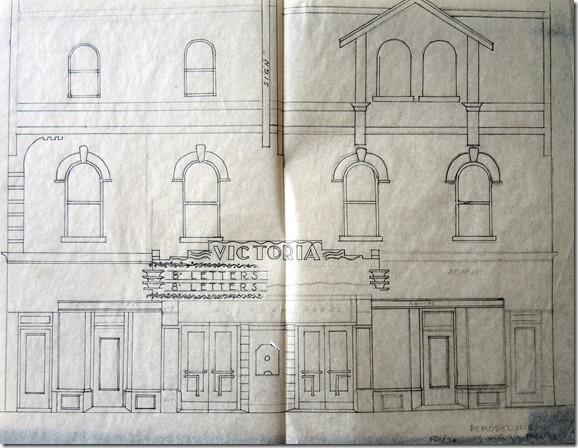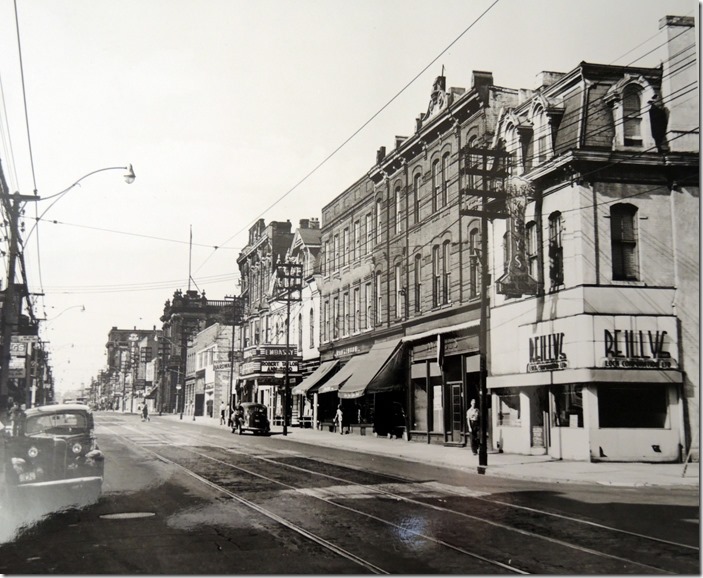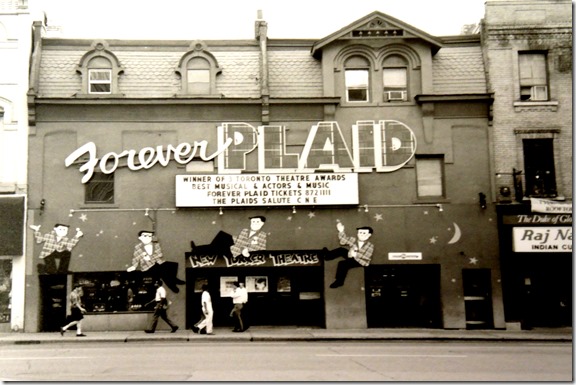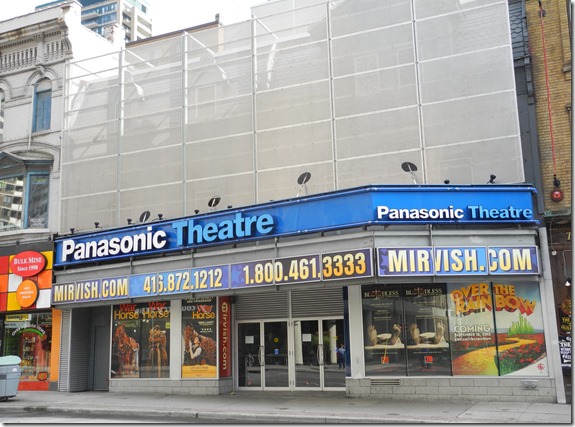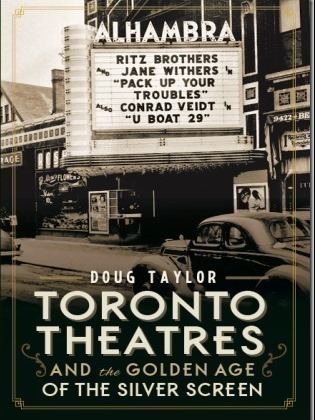The Panasonic Theatre is located on the east side of Yonge Street, a short distance south of Bloor Street. It has changed named several times in its long history. In April 2015, in the Ontario Archives, I discovered several photos and a sketch of the theatre that I had not seen before.
The theatre commenced its life in 1919 as the Victoria, when two Second-Empire houses on Yonge Street were renovated to create a theatre. The above sketch reveals the plans for remodelling the houses to create a theatre. The drawing shows the windows of the two former houses. The plans included shops on either side of the theatre’s entrance to provide rental income to offset the expenses of operating the theatre.
The theatre’s name was changed to the Embassy in 1932, as shown on the marquee in the above photo. Other names it has possessed include the Astor, Showcase, and Festival. In 1993 it became the New Yorker and was renovated to accommodate live theatre. It is presently named the Panasonic. The view in the photo gazes north on Yonge Street toward Bloor, from the corner of Isabella and Yonge Street. In the foreground, on the northeast corner of Yonge and Isabella is a shop of the Reilly Lock Company, founded in 1932.
This photo shows the New Yorker theatre in 1993, when it featured “Forever Plaid,” a spoof of the male harmony groups of the 1950s. The facade of the theatre shown in the 1919-sketch remains intact in this photo. Even the shop on the north side of the entrance can be seen. To create the Panasonic Theatre, the building was demolished, except for the facade, which today is covered with metal meshing. However, it remains visible beneath it.
The Panasonic Theatre in 2015.
For a link to a more in depth post about the Panasonic Theatre:
Location of the Panasonic Theatre.
To view the Home Page for this blog: https://tayloronhistory.com/
To view previous blogs about movie houses of Toronto—historic and modern
Recent publication entitled “Toronto’s Theatres and the Golden Age of the Silver Screen,” by the author of this blog. The publication explores 50 of Toronto’s old theatres and contains over 80 archival photographs of the facades, marquees and interiors of the theatres. It relates anecdotes and stories of the author and others who experienced these grand old movie houses.
To place an order for this book:
Book also available in Chapter/Indigo, the Bell Lightbox Book Store and by phoning University of Toronto Press, Distribution: 416-667-7791
Theatres Included in the Book:
Chapter One – The Early Years—Nickelodeons and the First Theatres in Toronto
Theatorium (Red Mill) Theatre—Toronto’s First Movie Experience and First Permanent Movie Theatre, Auditorium (Avenue, PIckford), Colonial Theatre (the Bay), the Photodrome, Revue Theatre, Picture Palace (Royal George), Big Nickel (National, Rio), Madison Theatre (Midtown, Capri, Eden, Bloor Cinema, Bloor Street Hot Docs), Theatre Without a Name (Pastime, Prince Edward, Fox)
Chapter Two – The Great Movie Palaces – The End of the Nickelodeons
Loew’s Yonge Street (Elgin/Winter Garden), Shea’s Hippodrome, The Allen (Tivoli), Pantages (Imperial, Imperial Six, Ed Mirvish), Loew’s Uptown
Chapter Three – Smaller Theatres in the pre-1920s and 1920s
Oakwood, Broadway, Carlton on Parliament Street, Victory on Yonge Street (Embassy, Astor, Showcase, Federal, New Yorker, Panasonic), Allan’s Danforth (Century, Titania, Music Hall), Parkdale, Alhambra (Baronet, Eve), St. Clair, Standard (Strand, Victory, Golden Harvest), Palace, Bedford (Park), Hudson (Mount Pleasant), Belsize (Crest, Regent), Runnymede
Chapter Four – Theatres During the 1930s, the Great Depression
Grant ,Hollywood, Oriole (Cinema, International Cinema), Eglinton, Casino, Radio City, Paramount, Scarboro, Paradise (Eve’s Paradise), State (Bloordale), Colony, Bellevue (Lux, Elektra, Lido), Kingsway, Pylon (Royal, Golden Princess), Metro
Chapter Five – Theatres in the 1940s – The Second World War and the Post-War Years
University, Odeon Fairlawn, Vaughan, Odeon Danforth, Glendale, Odeon Hyland, Nortown, Willow, Downtown, Odeon Carlton, Donlands, Biltmore, Odeon Humber, Town Cinema
Chapter Six – The 1950s Theatres
Savoy (Coronet), Westwood
Chapter Seven – Cineplex and Multi-screen Complexes
Cineplex Eaton Centre, Cineplex Odeon Varsity, Scotiabank Cineplex, Dundas Square Cineplex, The Bell Lightbox (TIFF)
